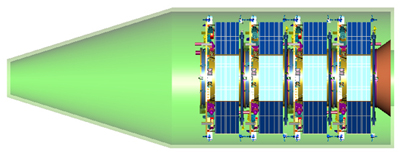 MMS successfully launched from Kennedy Space Center
MMS successfully launched from Kennedy Space Center
on March 12, 2015.
Read more...
About the Magnetospheric
Multiscale Mission
MAGNETIC RECONNECTION is a little-understood physical process at the heart of space weather. It can spark solar flares, cause coronal mass ejections and other phenomena that can imperil Earth-orbiting spacecraft and disrupt power grids on Earth.
Much of what we know about the physics of Magnetic Reconnection comes from theoretical studies and computer models. MMS will study this process in situ, measuring magnetic fields crossing, reconnecting, and releasing magnetic energy in the form of heat and charged-particle kinetic energy.
The breaking and reconnection of the magnetic field lines takes place in a narrow boundary layer called the diffusion region.
Science Goals
The overarching goal of the MMS mission is to measure the plasma and the electric and magnetic fields inside the diffusion regions in Earth's magnetosphere in order to answer the following fundamental questions:
- What conditions determine when reconnection is initiated and ceased?
- What determines the rate at which reconnection occurs?
- What is the structure of the diffusion region?
- How do the plasma and magnetic fields become decoupled in the diffusion region? In particular, what role do the electrons play in facilitating reconnection?
- What is the role of turbulence in the reconnection process?
- How does reconnection accelerate particles to high energies?
The plasma and fields instruments will measure ion and electron distributions and the electric and magnetic fields with unprecedented high (millisecond) time resolution and accuracy. These measurements will enable MMS to locate and identify small (10's of km) and rapidly moving (10-100 km/s) diffusion regions, to determine their size/structure, and to discover mechanism(s) by which plasma and magnetic fields decouple, reconfiguring the magnetic field.
 |
|
| The four MMS spacecraft will be in a stacked configuration on a single launch vehicle. |
MMS SMART Investigation team...
MMS Science Payload...
MMS-FIELDS Instrument Suite...



